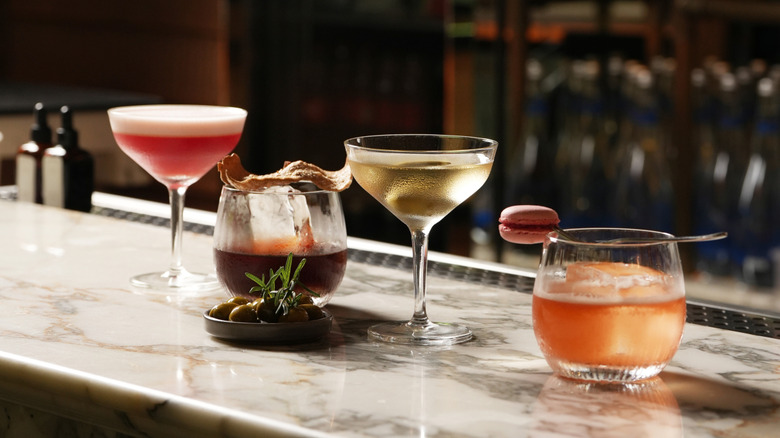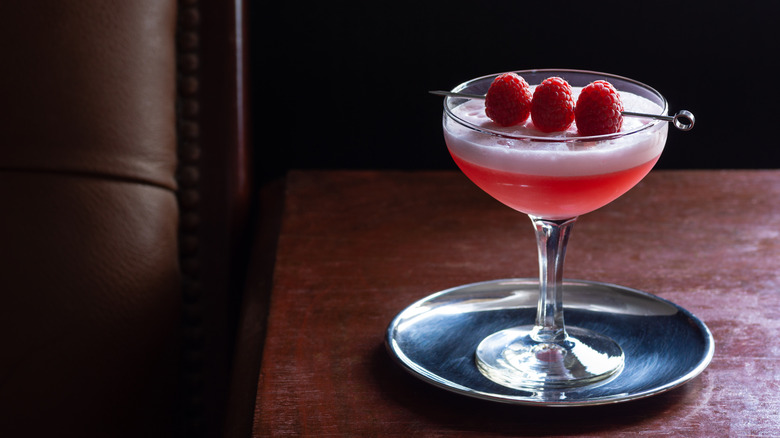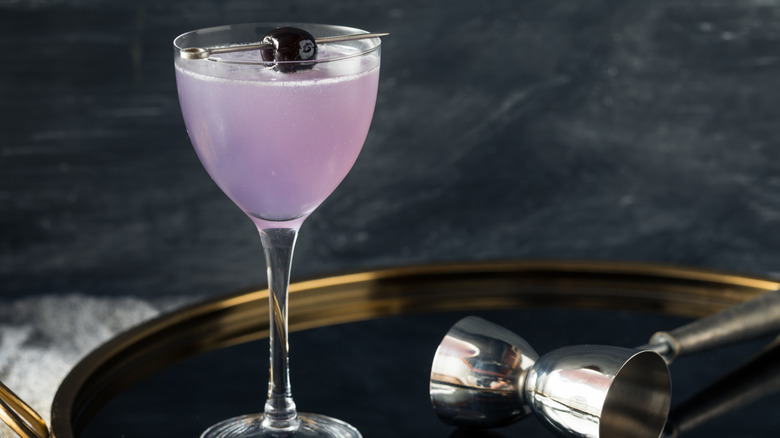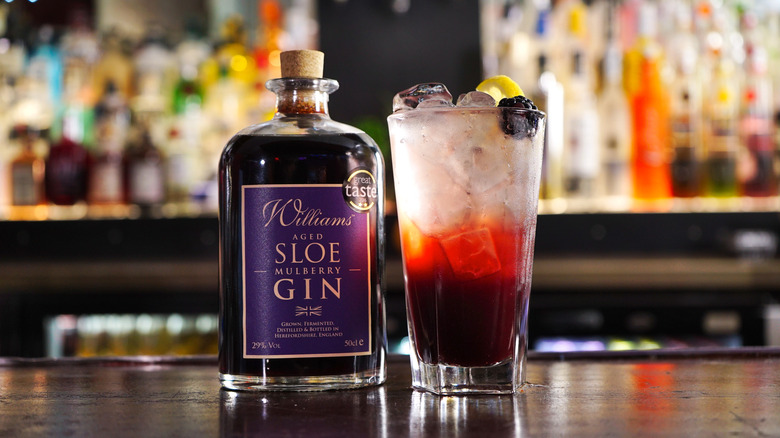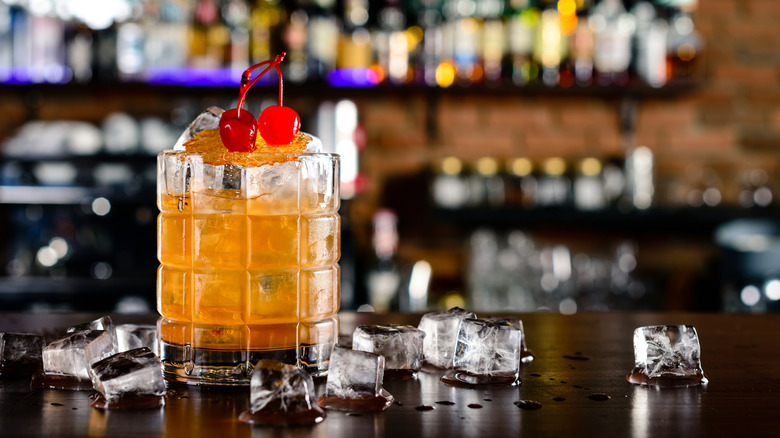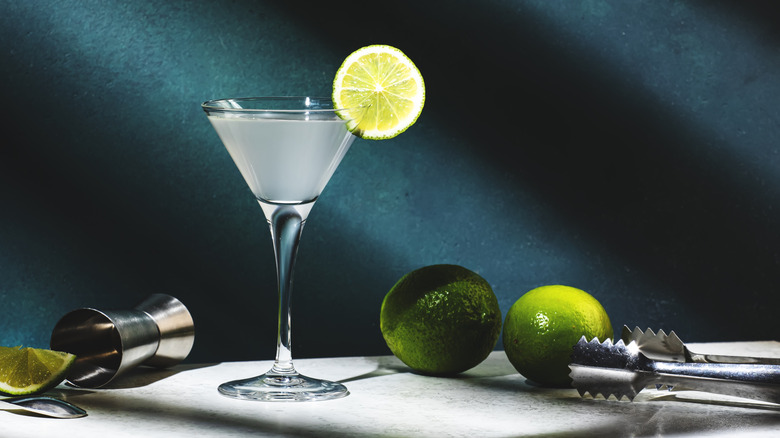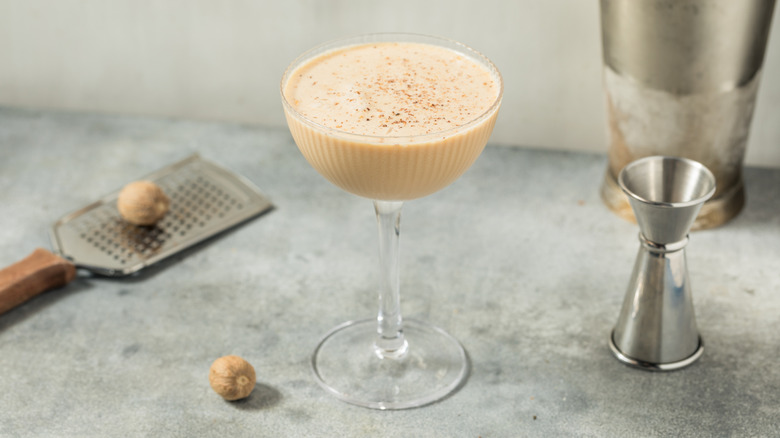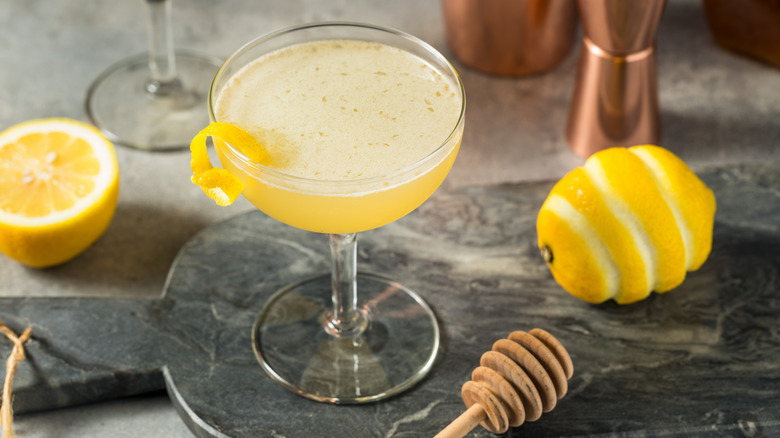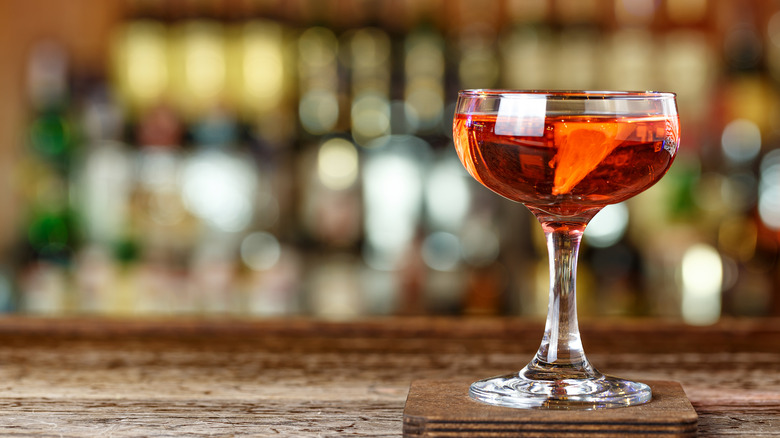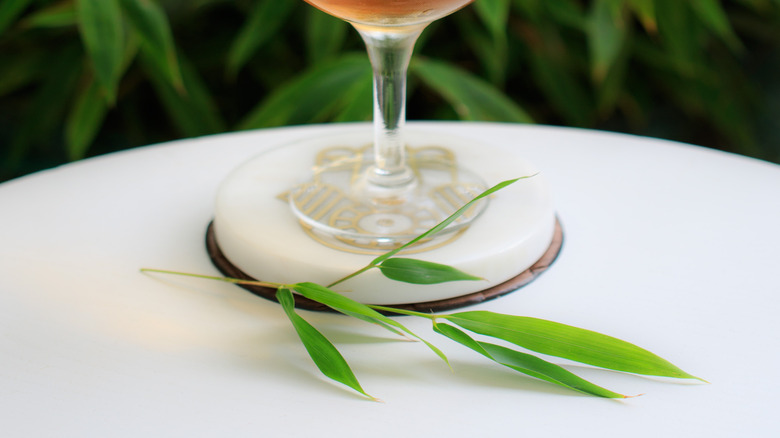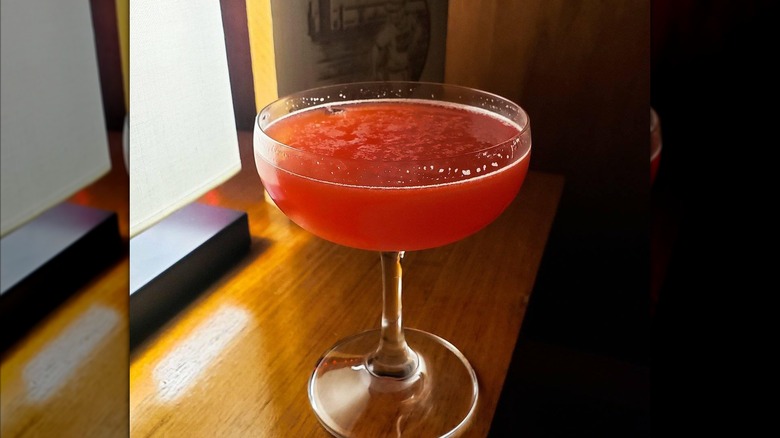10 Forgotten Classic Cocktails That Should Make A Comeback
When sidling up to a bar or making drinks at home, there are few things better than a classic cocktail. The elegance, sophistication, and rich history behind some – like the martini or the Old Fashioned – have allowed them to stand the test of time, earning permanent spots on bar menus. Others have vanished into obscurity, and frankly, plenty deserved their fate. (Some of the sickly sweet ones popular in the 1970s can stay buried.) However, some of these lost gems shouldn't have disappeared, so we've compiled a list of the ones we think deserve a place alongside today's favorites.
Each of these cocktails tells a story about American drinking history, from the sooty railroads to glamorous socialite parties of the early 1900s. They're also fantastic conversation starters. You know a bartender truly knows their craft when they can mix one of these forgotten classics. Try making them yourself at a party, and watch guests lean in as you retell stories of speakeasies operating 12 miles out to sea during Prohibition, or the favorite tipple of a beloved hard-boiled literary detective.
Of course it's the taste that matters most, and these cocktails score top marks. They run the gamut of delicious flavors from John Lennon's favorite chocolatey boozy tipple that taste like a delicious desert, to a delicately floral drink flavored with violets that will make you feel like a romantic Victorian poet. When it comes to forgotten classics, there is something for all tastes.
Clover Club
It was the late 1800s in a Philadelphia men's club. Polished wood paneling gleamed under gaslight, leather chairs creaked with the weight of important conversations, and cigar smoke curled through the air as titans of industry struck their deals. The atmosphere was all masculine gravitas and serious business. So what were these powerful men sipping during such weighty affairs? A frothy pink cocktail, of course. The Clover Club was the drink of choice at this exclusive gentleman's establishment.
This elegant cocktail brings together gin, fresh lemon juice, and raspberry syrup, all shaken vigorously with egg white until beautifully frothy. The result delivers the perfect balance of sweet and sour, with a fruity blast of raspberry. The egg white adds a luxuriously silky texture and frothy head.
We love that this has a bit of complexity but also is made with ingredients you can find at home. You won't need to hunt down obscure liqueurs or specialty ingredients. The raspberry syrup is easily made at home by dissolving sugar in water, adding fresh raspberries, then straining out the pulp once the flavors have melded. To build your Clover Club, combine two ounces of gin, with half an ounce each of fresh lemon juice and raspberry syrup in a shaker, add one egg white, shake vigorously until frothy, then strain into a chilled coupe and garnish with three fresh raspberries. For an extra layer of complexity, if you have it on hand, you can substitute half an ounce of dry vermouth for some of the gin.
Aviation
The aviation is a gin-based cocktail that gets its distinctive purple hue from crème de violette, a liqueur crafted from violet petals. The result is a delicately floral drink that tastes like spring captured in a glass.
This cocktail's roots stretch back to the late 1800s, when violet flavored treats were in vogue. The flower found its way into candies, syrups, and sweets of every kind. People were obsessed with violet everything. Naturally, someone had to try putting it in booze. The first recorded aviation recipe appeared in 1916, when bartender Hugo Ensslin published it in his "Recipes for Mixed Drinks." His version called for gin, maraschino liqueur, crème de violette, and fresh lemon juice.
But tastes evolve, and the aviation slowly fell from grace. By the 1960s, crème de violette producers had stopped making the liqueur entirely. For four decades, this cocktail became impossible to recreate in its original form. During the 1990s craft cocktail renaissance, bartenders would stumble across Ensslin's recipe and wonder about this mysterious purple drink. They'd try making versions without the crème de violette, but something was always missing.
Then 2007 rolled around, and a Minneapolis importer began sourcing crème de violette from an Austrian distiller, making it easier to access in the States. Now bartenders could make a proper Aviation again. Other producers quickly followed suit, and this nearly century-old cocktail became possible once more. Today the aviation still remains unknown to most drinkers, but one of the world's oldest cocktails deserves far more recognition than it currently receives.
Sloe gin fizz
This fizzy, ruby-red drink has practically vanished from American bars, taking with it one of the most unique flavor profiles in the cocktail world. The star ingredient is sloe gin, a British liqueur made by infusing gin with sloe berries and sugar. These berries grow wild in English hedgerows, sporting a deep purple color and plumply hanging like jewels from blackthorn bushes. They appear so delicious that you'd want to pop a handful in your mouth immediately. Don't. Sloes are the most astringent thing you'll ever taste, sucking every drop of moisture from your mouth, they make lemons taste like candy.
But the British are clever people, and centuries ago they figured that drowning the berries in gin — as well as adding some sugar and letting time work its magic — transforms them into something magnificent. The gin takes on their deep color and develops a rich, tart complexity unlike any other spirit.
Sloe gin was traditionally a winter warmer, sipped neat by the fireplace during Christmas. Then American bartenders in the early 1900s discovered it and gave it their own spin. They took the popular gin fizz recipe (gin, lemon juice and soda water) and swapped in sloe gin, creating this delightful tipple that's tart and refreshing. It enjoyed popularity through the 1960s before fading away. Today, with quality sloe gin finally available again in the U.S., this forgotten fizz deserves to reclaim its place in our bars.
Harvey Wallbanger
The Harvey Wallbanger is essentially a screwdriver (vodka and orange juice) with a splash of Galliano — a golden Italian liqueur that's made from a blend of botanicals like mint, vanilla, and star anise. Simple as it sounds, this three-ingredient cocktail became one of the biggest drink sensations of the 1970s.
The Harvey Wallbanger was the result of a marketing concept that struck gold. Bill Young was an artist, working in a small advertising studio in Lima, New York in 1969. While working on a campaign for Galliano and McKesson, Young created a strange cartoon character for the brand. Picture an anxious guy with massive feet, squiggly hair, and orange skin wearing the same vacant, stressed expression while surfing and skydiving. His tagline was simple: "Harvey Wallbanger is the name and I can be made!" The recipe appeared right on every poster in bubble letters: "6 oz. O.J. — 1 oz. vodka — Stir with ice — Splash in ½ oz. Galliano."
It worked incredibly well. Galliano became the most imported liqueur of the decade, moving around 500,000 cases annually in the U.S. Young's cut was substantial enough that he traded his Volkswagen for a BMW. However, by the early 1980s, Harvey had vanished along with disco balls and polyester suits. But for one shining decade, this Italian liqueur-spiked screwdriver ruled American bars.
Why do we love it? It's the perfect brunch drink, particularly if you want a little more oomph than you get from basic mimosas. The Harvey Wallbanger is wonderfully easy — just three ingredients — but it's got complexity and depth thanks to the spicy, herbal notes of the Galliano.
Gimlet
We love when drinks come with great stories, and the gimlet delivers one of the best. Its roots trace back the 1800s when the British Navy and merchant ships were required to carry daily rations of limes to prevent scurvy. The lime juice was initially preserved in rum but in 1867 Lauchlan Rose invented and patented a method that used sulfurous acid instead. Both the Admiralty and the public embraced Rose's Lime Cordial immediately, and it became one of the earliest mass-produced soft drinks, and is still the largest seller of bottled lime juice today.
There would be another influence on the popularity of this simple drink. In 1954, Raymond Chandler published "The Long Goodbye," a novel that was part of a series with a heavy drinking, wise-cracking yet world-weary protagonist, Phillip Marlowe, who prowled the seedy streets of 1940s Los Angeles, solving crimes. The gimlet was his choice of tipple and features heavily in the novel. The book and subsequent films became a cultural institution of the time and catapulted the gimlet into popularity, much like what James Bond did for the martini, though it didn't have quite the notoriety or staying power.
Though it's not necessarily a common cocktail order, there are fun modern takes this classic like our yuzu and sesame version, or this one made with celery bitters. Marlowe's gimlet was made with equal parts Rose's Lime Cordial and gin, but today's bartenders eschew the cloying sweetness, preferring fresh lime juice with simple syrup and gin, also often using vodka as an alternative. The result is drink that is deliciously tart and refreshing with an ever so stylish history.
Brandy Alexander
Don't be fooled by the innocent appearance of a Brandy Alexander — it's a dangerous drink. This creamy, dessert-like cocktail is a chocolate lover's dream; the only problem is that it goes down far too easy.
The first alexander was gin-based. It was created by bartender Troy Alexander at Rector's in New York City. This white cocktail was crafted for a special dinner celebrating one of the most successful marketing campaigns of the era. Back then, travelling by coal-fueled rail was extremely dirty, covering passengers in soot. Enter Phoebe Snow, a fictional character dressed entirely in white who became the face of the new clean-burning anthracite trains. Her pristine white outfit proved that this new technology wouldn't leave you looking like a chimney sweep. The Alexander, with its white appearance from gin, cream, and crème de cacao, was the perfect cocktail to celebrate this marketing triumph.
Somewhere along the way, some genius had the bright idea to substitute gin for brandy, creating what we now know as the Brandy Alexander. The results were superb, and the brandy version quickly became the favorite. This cocktail gained notorious fame through John Lennon. Back in 1974, fellow songwriter Harry Nilsson introduced Lennon to Brandy Alexanders at The Troubadour nightclub in Hollywood. The evening ended with Lennon getting kicked out for drunken shouting and causing a scene, so although this cocktail is absolutely delicious, proceed with caution!
Bee's knees
The bee's knees is a variation of the classic Gin Sour (gin, lemon and sugar) that swaps sugar for honey. The drink emerged in 1929 during Prohibition, with competing origin stories that are probably both kind of true. One tale credits Margaret Brown, the American socialite famously known as the "Unsinkable Molly Brown" after surviving the Titanic disaster (portrayed by Kathy Bates in the 1997 film). An April 1929 Brooklyn Times-Union article mentioned the cocktail while discussing the trendy women-only bars in Paris where Brown was reportedly a regular. The other story credits Frank Meier, a bartender whose recipe appeared in the 1929 book "Cocktails de Paris." Whether Meier created it specifically for Brown or she simply adopted it as her signature drink remains unclear. Either way, you can picture a glamorous socialite declaring "Oh darling, it's absolutely the bee's knees!"
The bee's knees has largely disappeared from modern cocktail menus, but we think it deserves a revival. The botanical complexity of honey pairs beautifully with gin's herbal character, while also mellowing the spirit's sharper edges for a smoother, more balanced drink. Although honey and lemon sounds like a remedy for a cold, trust us — it makes a delicious cocktail.
El Presidente
Meet the Martini of Cuba. While Americans were drowning their sorrows in bathtub gin during Prohibition, the El Presidente was holding court in Havana's finest bars, serving as the sophisticated cocktail of choice for those who could afford to escape the dry years in style.
This elegant rum cocktail was named after Mario García Menocal, who was President of Cuba from 1913 to 1921. During his presidency and the years that followed, prominent Americans discovered that a short boat ride to Havana could cure the tedium of Prohibition. Picture wealthy socialites, business moguls, and celebrities gathering in opulent Cuban hotels, sipping cocktails that would have been impossible to find back home.
The El Presidente became their drink of choice, and for good reason. This cocktail combines light rum with vermouth blanc, orange curaçao, and a dash of grenadine. The magic lies in that vermouth blanc, the clear, sweet, herbaceous variety that put the Alpine town of Chambéry on the map. The flavor profile is complex. There's caramel from the rum, brightened with orange from the curaçao, while the elderflower and vanilla of the vermouth blanc lightens everything up. If you love rum, and want a cocktail with sophistication and depth, this one's for you.
Bamboo
The bamboo cocktail consists of equal parts vermouth and dry sherry with a few dashes of bitters. It was created in Japan, in the 1890s at the Grand Hotel in Yokohama. This wasn't a drink created by Japanese bartenders, though. The story belongs to a group of homesick Americans and one talented German mixologist.
The Grand Hotel was partly owned by American military personnel stationed in Japan during this period. These servicemen found themselves far from home, craving familiar tastes and comforts in an unfamiliar land. They needed someone who could bring a piece of American bar culture to their adopted island home, so they recruited Louis Eppinger for the task. Eppinger was a German bartender who had honed his skills in San Francisco. The military owners made an excellent choice. Eppinger became a beloved fixture at the Grand Hotel for 15 years, serving drinks until his death in 1907.
By 1901, this Japanese creation had crossed the Pacific and appeared on bar menus throughout America. The drink became popular enough that distillers eventually began selling pre-mixed bottled versions across the country. But tastes change, and the bamboo gradually faded from prominence. Maybe it was because sherry fell out of fashion, or the cocktail's lower alcohol content didn't align with modern drinking preferences. Whatever the reason for its demise, we think it deserves a comeback. This is the perfect cocktail for those who want the sophistication of a martini without the boozy punch. The fortified wines deliver rich, layered flavors that you can sip slowly and savor.
12 Mile Limit
During Prohibition, law enforcement had to patrol thousands of miles of coastline to stop alcohol smugglers. The sheer scale of America's borders made the task nearly impossible, and enterprising criminals quickly figured out how to exploit this weakness. Rumrunners could legally purchase enormous quantities of liquor in Europe, the Caribbean, and Canada, then sail to American waters, with their choice of landing spots along the entire coast. The most clever operators never even bothered coming to shore. Instead, they anchored just outside federal jurisdiction (12 miles from shore) and had the buyers and party goers come to them.
These offshore speakeasies became legendary during the dry years. Picture ships bobbing in international waters, their decks crowded with thirsty Americans who had sailed out for a legal drink and a good time. Beyond that invisible line, drinking was perfectly legal, and these floating bars thrived in the safety of the sea.
Franklin Fairfax Millard, a war correspondent and journalist, is said to have created this cocktail to commemorate this clever circumvention of Prohibition law. His 12 Mile Limit combined white rum, whiskey, lemon juice, brandy, and grenadine. We love this one — it's a drink that's spirit-forward, and the three base liquors aren't ones you typically see combined. The rum, lemon and grenadine give this a tropical vibe, while the whiskey and brandy brings a woody warmth and spice. It's beachy and boozy, a perfect fit for its namesake.

